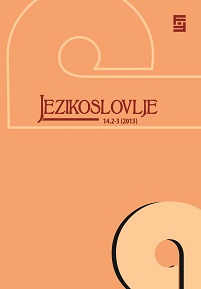The polysemy of verbs expressing the concept SIT in English, Croatian and German
The polysemy of verbs expressing the concept SIT in English, Croatian and German
Author(s): Dubravka Vidaković ErdeljićSubject(s): Language and Literature Studies
Published by: Filozofski fakultet, Sveučilište Josipa Jurja Strossmayera, Osijek
Keywords: posture verbs; SIT; polysemy; metonymy; embodiment
Summary/Abstract: This paper presents the findings of a corpus-based research of the posture verb SIT in English, Croatian and German. In line with the central tenets of cognitive linguistics we argue that figurative meanings of this verb are motivated by bodily experience and grounded in image schemas such as CONTAINMENT and GOOD-FIT and as such follow roughly the same paths of meaning extension in the languages under scrutiny. The results of our analysis also imply that differences noted among English, Croatian and German can partly be attributed to different levels of saliency of particular image schemas in the three languages (e.g. figurative extensions based on the image schema CONTAINMENT are much more prominent in English and German than in Croatian). We also maintain that the divergent paths of the meaning extension of verbs expressing the concept SIT in English, Croatian and German can be put down to idiosyncratic features of these languages which are by analogy extended from one construction or pattern of use to another. Such processes explain why it is possible for English sit, unlike Croatian sjediti and German sitzen, to behave as a transitive verb (e.g. in sentences: sit the child on a chair, sit meat on a plate).
Journal: Jezikoslovlje
- Issue Year: XIV/2013
- Issue No: 2-3
- Page Range: 263-279
- Page Count: 17
- Language: English

